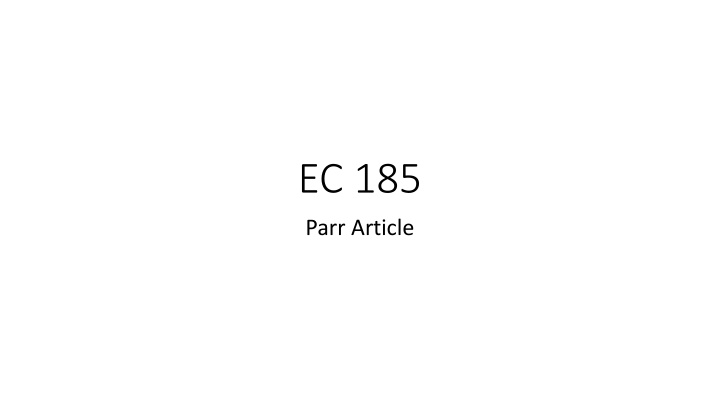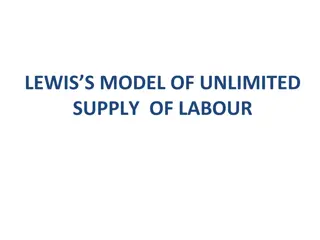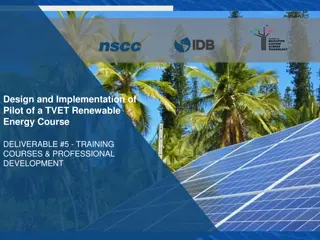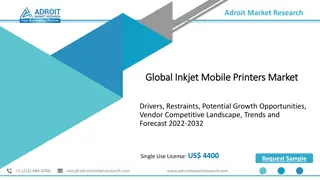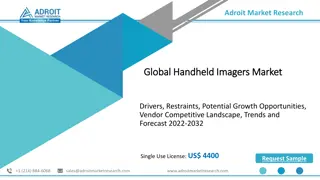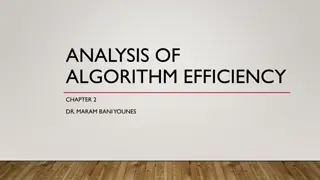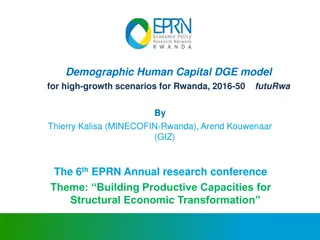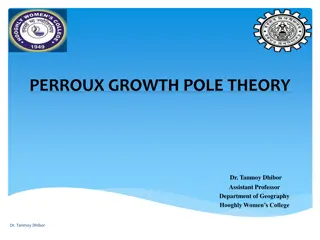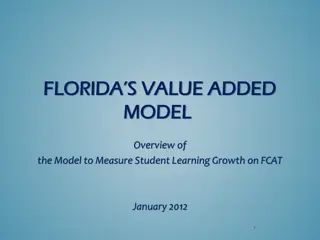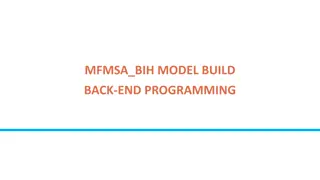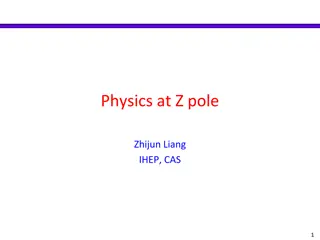Thorough Analysis of Growth Pole Model
This analysis delves into the Growth Pole Model, its intended goals including regional decentralization and inter-regional balances, visual development of regions, induced poles, emphasis on propulsive industries, and development with multiple investments. It also evaluates the model's focus on natural poles, specific targets, and critiques regarding its implementation. The article provides insights into the theory, goals, and practical applications of the Growth Pole Model.
Download Presentation

Please find below an Image/Link to download the presentation.
The content on the website is provided AS IS for your information and personal use only. It may not be sold, licensed, or shared on other websites without obtaining consent from the author.If you encounter any issues during the download, it is possible that the publisher has removed the file from their server.
You are allowed to download the files provided on this website for personal or commercial use, subject to the condition that they are used lawfully. All files are the property of their respective owners.
The content on the website is provided AS IS for your information and personal use only. It may not be sold, licensed, or shared on other websites without obtaining consent from the author.
E N D
Presentation Transcript
EC 185 Parr Article
Parr Article Parr Article Thorough Analysis of the Growth Thorough Analysis of the Growth Pole Model Pole Model A retrospective Looks back at the initial theory, its goals and actual applications Intended Goals: Regional Decentralization Modification of National Urban System Deconcentration Inter-regional Balances
Visually Development of a Region. Natural Pole Resource endowment (minerals, river, transportation center) Development spreads from center to rest of region
Farther away from center, effects less important Out of brown circle, enter periphery Region of low economic vitality Examples- Bakken Ridge (North Dakota) Chicago
Induced Poles Tend to be Much Smaller Deliberate placement within a region to spur development Automobile plant
Emphasis is on propulsive industries An economic activity that can push a region forward Car manufacturing, defense, high tech Electric Boat or Sikorsky would be the best example for Connecticut Creates high-paying jobs, linkages to other industries
Initially all Focus was on Natural Poles Characteristics: Ability to attract capital Innovation Entrepreneurship Natural poles were supposed to be large (>250,000 people) Parr is critical of over-emphasis on growth poles Ignored alternatives (e.g. transportation)
Specific Targets: Revive a depressed area Labor should then move to seek jobs Regional decentralization Modifying the national urban system Addressing concerns about over-population in specific areas by spreading out growth Attempt to avoid strains on urban transportation, housing, space, etc. Critics noted that the anticipated over-growth did not occur
Turning to the Developing World Turning to the Developing World Application of these strategies was supposed to help countries avoid the mistakes of the West Prevent dominance of a few cities (and the problems that arise when power is centralized) Parr notes that a small difference in costs promoted by a development plan may be overwhelmed by economic advantages of the central city Funnel development into regions that would traditionally be left behind Create even development that lifts country out of underdevelopment, not just a few urban centers
Strategy May Backfire Strategy May Backfire The more diffuse the spending, the less impactful it is Political consideration may force lots of small projects across diverse regions, rather than a few large investments Results may be disappointing
Page 14 Nuts and Bolts of Strategy Planned Development Natural growth poles are great, but entirely random Limited # of poles To work, need large investment Diffusion of investment across many regions will make it ineffective Requires alteration of employment and skill set of labor pool
Requires Concentration of Infrastructure Requires Concentration of Infrastructure To succeed, favored areas must be supported by transportation assets Roads, rail, etc. May create resentment among leaders in other regions
Two Potential Positive Outcomes First (as noted) the concentration of infrastructure Two, the pull of positive resource (e.g. labor) into the region Which raises another critique What happens to rest of area that is outside growth pole?
Traditional Methods of Planning for Traditional Methods of Planning for Development Development Assess: Problems that need to be addressed Employment, urban blight, poor growth Solutions to problem Cost and impact Role of private sector and government Post-initiative evaluation (did it work?)
Case Study Case Study Downers Grove, IL City of just under 50,000 in near suburbs of Chicago $88,000 median household income Very small population growth (2% in 15 years) Downtown thrived for years Construction of malls pulled customers out of downtown Downtown began to look worn-out Vacant store fronts, etc.
Downtown Revitalization Worked on specific areas (Ogden Ave.) Promoted downtown businesses Tried to draw shoppers back into downtown Specific development projects were promoted http://www.downers.us/public/docs/departments/co m_dvlpment/1999_Ogden_Avenue_Master_Plan.pdf
Compiled Long List of Redevelopment Opportunity sites Promoted these sites to developers and businesses Town experienced a modest revitalization Drain from malls continues, but has been pushed back against
Importance of Industrial Choice Ideally focus on so-called propulsive industries Those that move a region forward At best, a cluster of firms that produce intertwined products Also want to focus on high-technology, high rate of return sectors Promoting old industry may lead to failure, as industry may decline like it has elsewhere
Economics High Value-Added Means firms can also pay high wages Low elasticity of demand Can secure a high price without driving out customers Linkages Both backward and forward Back pulls from other industries in the region Forward pushes products out to other firms in the area
Example Example Machine tools Machines that are custom designed for high-end manufacturing Machines that can make machines or high-end end products Drill press Businesses input components to machine tool producer Producer pushes end product out to other producers
Can Reinvigorate and Entire Area Can Reinvigorate and Entire Area Creates multitude of high-paying jobs Cities compete for firms of this kind
Shift Shift- -Share Analysis Share Analysis Attempt to explain why employment is growing in a particular region Compares regional focus to national focus based upon industrial concentration Example: Automobile industry nationally 3-3.5 percent of total output San Antonio, TX Toyota Manufacturing Plant Share of local output would exceed the national average Share of employment due to car output would be more significant
How Shift-Share is Used Compares national growth to regional growth based upon regional specialization Area that is focused on rapidly growing industry will outdo country as a whole From a development perspective Particular region might focus on an industry that is more likely to produce rapid growth It will do better than the nation as a whole
Components of Each Report (In Order) Overview Why Norwalk (or Westport or Fairfield ) Demographic and economic data Transportation and amenities housing Summary of office market Recent construction (commercial) Residential Real Estate Employment and Labor Statistics Crime and Quality of Life (with comparisons to other cities)
Page format 2 column Photos embedded when appropriate (at least 6 photos per report) Each report should include a map of new commercial construction, amenities, transportation assets Footers on each page Contact information on last page
Timeline 6 weeks to completion (with spring break in the middle) March 8: Basic GIS map of each town completed with transportation and amenities labeled (2 groups) List of major commercial properties and location Basic demographic data from ACS or Census Quickfacts Basic report layout done Photography started - Amenities
March 22: GIS map of each town s commercial properties (2 groups) List of new and proposed commercial properties and location Augmented list of amenities schools, parks, places of worship, libraries, beach Demographic data from ACS or Census Quickfacts regarding education, health, other quality of life statistics Basic report layout done Photography continued public buildings and corporate spaces
March 29: GIS map of each town s zoning List of new residential construction Augmented list of amenities (3) Universities, colleges, hospitals, in town and nearby Demographic data from ACS or Census Quickfacts regarding your city versus State or U.S. Basic report layout done Photography completed
April 5: Text inserted around figures, data, photos, etc. April 12: Revised text and complete report
